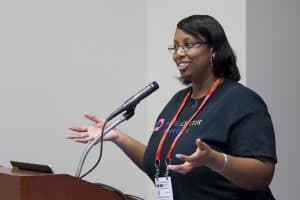
If we build our libraries on the assumption that youth matter, how then are we tangibly realizing this idea in our programs and services? Not only do our youth matter, but they also have valuable perspectives. We must meaningfully integrate who they are into our libraries and our work, consistently and joyously.
One way I’ve been fortunate enough to do this in my middle school library has been through an initiative called the #LibFive. With 8th graders Cesar Falcon, Jose Gomez, and Jaida Morris, the #LibFive has leveraged teen insights and experiences to create a student-driven professional development program for youth librarians—initially in our district and eventually across the US.
Our project was based on an initiative from the Chapel Hill–Carrboro (N.C.) City Schools Blue Ribbon Mentor–Advocate Program called the Student Six. The “six” refers to six culturally sustaining strategies for educators to better connect with students of color. The power of the Student Six made me want to explore this idea with teens, viewed through the lens of libraries.
The students at our alternative school have had experiences with multiple schools; they come to us and rewrite their school stories. Part of that rewriting happens in the library. I chose to work with three students who I saw often for an enrichment and remediation period.
To build a professional development framework, I guided Cesar, Jose, and Jaida through research. We looked at the powerful Mary Stone Hanley and George W. Noblit study “Cultural Responsiveness, Racial Identity, and Academic Success: A Review of Literature” (2009), which found that positive racial identity leads to academic success for youth of color. From there, we unpacked the state of representation in books today and discussed the themes of #OwnVoices, counterstories, and the necessity of building reflective collections.
The possibilities for teen input are infinite—from programming and lesson planning to policies and physical layout.
The students then did their own action-based research. They conducted library walks and considered the time they spent at libraries at their base schools. We brainstormed what makes a library feel welcoming and spoke to other students about their experiences. After months of work, we came up with the #LibFive—the five biggest ways that libraries can build an inclusive environment. They are:
- See me. Listen to me.
- Show me on the shelves and walls. Read those books yourself.
- Graphic novels and manga are not extra.
- Show the joy in our stories.
- Make the library a sorting-free zone.
By sorting, we mean separating students by perceived ability, grades, compliance, or other factors. Our libraries should not sort students but treat all visitors as readers and scholars. To illustrate the harm of sorting, my students use book fairs as an example: Classes are broken into groups based on who has money to shop at the fair and who does not.
Using the #LibFive, we built a training session for librarians where Cesar, Jose, and Jaida share their perspectives and research. The list might seem obvious or simple, but I would implore people thinking along those lines to reflect and reconsider. The principles are powerful because of their simplicity. As Jose says at the end of our session, “These reasons help explain why we love our library so much. We want every library to also do these five things.”
The #LibFive can be universally applied to any library that serves youth—from school to special to public. I’ve pulled the foundations into an infographic that can be printed and shared. I also invite you to think about an issue or opportunity in your library right now that you can explore with youth. The possibilities for teen input and design are infinite—from programming and lesson planning to policies and physical layout.
Authentically including teens in building an inclusive library not only improves service for all but shows them that they matter—through supported expression, the creation of empowered spaces, and the amplification of their amazing voices.


